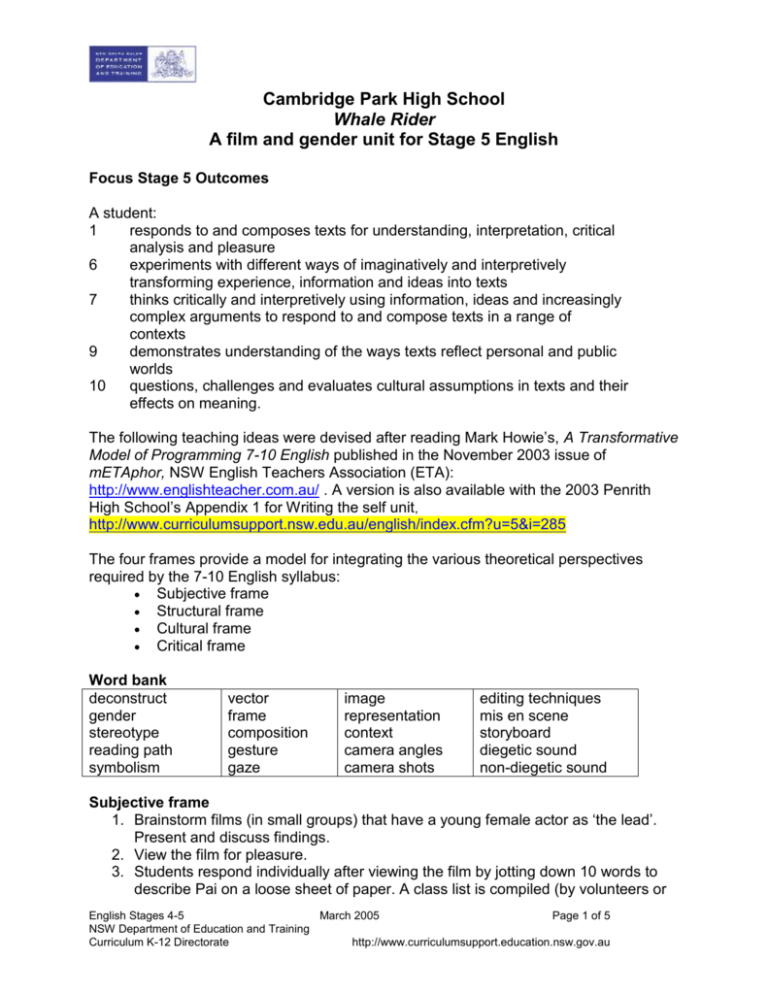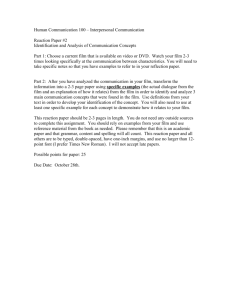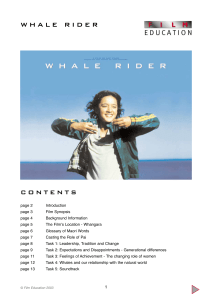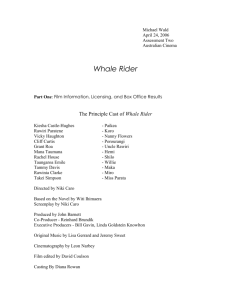Whale Rider unit - Curriculum Support
advertisement

Cambridge Park High School Whale Rider A film and gender unit for Stage 5 English Focus Stage 5 Outcomes A student: 1 responds to and composes texts for understanding, interpretation, critical analysis and pleasure 6 experiments with different ways of imaginatively and interpretively transforming experience, information and ideas into texts 7 thinks critically and interpretively using information, ideas and increasingly complex arguments to respond to and compose texts in a range of contexts 9 demonstrates understanding of the ways texts reflect personal and public worlds 10 questions, challenges and evaluates cultural assumptions in texts and their effects on meaning. The following teaching ideas were devised after reading Mark Howie’s, A Transformative Model of Programming 7-10 English published in the November 2003 issue of mETAphor, NSW English Teachers Association (ETA): http://www.englishteacher.com.au/ . A version is also available with the 2003 Penrith High School’s Appendix 1 for Writing the self unit, http://www.curriculumsupport.nsw.edu.au/english/index.cfm?u=5&i=285 The four frames provide a model for integrating the various theoretical perspectives required by the 7-10 English syllabus: Subjective frame Structural frame Cultural frame Critical frame Word bank deconstruct gender stereotype reading path symbolism vector frame composition gesture gaze image representation context camera angles camera shots editing techniques mis en scene storyboard diegetic sound non-diegetic sound Subjective frame 1. Brainstorm films (in small groups) that have a young female actor as ‘the lead’. Present and discuss findings. 2. View the film for pleasure. 3. Students respond individually after viewing the film by jotting down 10 words to describe Pai on a loose sheet of paper. A class list is compiled (by volunteers or English Stages 4-5 March 2005 Page 1 of 5 NSW Department of Education and Training Curriculum K-12 Directorate http://www.curriculumsupport.education.nsw.gov.au teacher) for homework and distributed next lesson. This list is displayed prominently. 4. Personal responses Students compose an entry in ‘their journal’ that responds to the film they have just viewed in exactly 50 words. Today we viewed (what was the film about?). Compose an entry for ‘Pai’s diary’ where she describes herself in exactly 50 words. Follow this with an entry in her grandfather, ‘Koro’s diary’ where he describes his granddaughter in exactly 50 words (students’ may ask at which point in the film as Pai’s grandfather’s perspective changes). It will be useful for students to reflect on what they have written (at this early stage) by the conclusion of the unit (after the critical frame). 5. The following study guides are useful for examining background material, themes, characters and plot: Film Education 2003 http://www.filmeducation.org/filmlib/WhaleRider.pdf English Online New Zealand, Whale Rider unit http://english.unitecnology.ac.nz/resource_exchange/resources/whalerider.pdf Structural frame 1. Brainstorm film jargon (small groups). Class definitions of the word bank (metalanguage) displayed around the room. 2. Posters of camera angles, shots and editing techniques displayed/constructed. 3. Students storyboard the following excerpt from the novel (in pairs): She was the whale rider. Astride the whale she felt the sting of the surf and rain upon her face. Either side the younger whales were escorting the leader through the surf. They broke through into deeper water. Her heart was pounding. She saw now she was surrounded by the whale herd. Every now and then, one of the whales would come to rub alongside the ancient leader. (Page 129) Students should be able to represent and discuss their complete vision for this adaptation including diegetic and non-diegetic sound, symbolism, camera angles, camera shots, editing, acting, lighting, special effects etc. (mis en scene). Teachers may wish to review this scene from the film (scene 15 on the DVD) either before or after student’s storyboard the excerpt. Cultural frame 1. Students provide popular magazines (that can be cut up) for homework. Each group of 4-6 makes two collages. One of representations of males, the other females. Each group records how gender is represented in popular magazines using the following prompts/table: clothing, facial expression and gaze, build, posture, body language, proximity, touch, activity, composition and gesture. English Stages 4-5 March 2005 Page 2 of 5 NSW Department of Education and Training Curriculum K-12 Directorate http://www.curriculumsupport.education.nsw.gov.au Contexts & Conventions (2001) by Rod Quinn and Hugh Rayner is a useful text for the next few questions, especially chapter 6. Representation clothing facial expression touch and proximity gaze posture proximity gesture body language activity Male Female 2. Define gender. How is gender represented in the media? How does the mass media impact upon constructions of identity? How have representations of gender changed since the 1970s? 3. Students compare and contrast group collages discussing if the images are traditional, dominant, sub-cultural, oppositional or emerging representations of gender in the media. 4. Groups present to the class with above table displayed on overhead projector/laptop and data projector 5. Read the SMH article, 29 January 2004: http://www.smh.com.au/articles/2004/01/28/1075088092523.html?from=storyrh s 6. Read, ‘Casting the Role of Pai’ (page 7 of the Film Education study guide: http://www.filmeducation.org/filmlib/WhaleRider.pdf) and view the special feature of Keisha Castle-Hughes’ audition for the role of Pai on the DVD before completing the following tasks: Why did the director see 10 000 children before finally casting Pai? What are some generic qualities of child stars in mainstream cinema? Are these different for art house? What qualities that led the director to cast Keisha Castle-Hughes? How does Castle-Hughes break the mould? How much of the success of the film can be attributed to the performance of Keisha Castle-Hughes? 7. Students read the following review, ‘The power of Maori myth’ by Jim Schembri from The Age, 9 May 2003: http://www.theage.com.au/articles/2003/05/09/1052280426878.html Any Australian visiting New Zealand is struck by how Maori are part of mainstream society, rather than on its fringes. The feeling of communal warmth that Whale Rider has generated is certainly testament to that. Also, the huge homeland success of a social critique such as Once Were Warriors shows how interested New Zealanders are in seeing films that reflect all aspects of Maori culture. English Stages 4-5 March 2005 Page 3 of 5 NSW Department of Education and Training Curriculum K-12 Directorate http://www.curriculumsupport.education.nsw.gov.au How interested are teenage Australians in seeing a diverse range of Australians represented in films? Design a survey to discover the opinion of your peers. Critical frame 1. Read the following article, ‘Releasing the magic of myths’ by Jennifer Little in The Age, 8 January 2004: http://www.theage.com.au/articles/2004/01/07/1073437329761.html He (Witi Ihimaera) credits much of his writing prowess to the influence of elderly women in his extended family who encouraged him to create "alternate texts" to the Anglo-Saxon nursery rhymes and fairytales he learned. His great-aunt Mini Tupara, would question him as to why Jack and Jill couldn't be Mere and Hemi, popular Maori names. In the case of Little Miss Muffet, he was urged to contemplate why the girl was so afraid of spiders - Maori revere spiders. Her questioning, he says, taught him the invaluable lesson that "sometimes we are told stories, and we must question them". Choose a traditional story (nursery rhyme, fairy story, myth or legend) and subvert the original message. You may choose to compose in a range of formats (comic, first or third person narrative, radio or film script). 2. Students return to the writing they did for question 4. Do you still think that is what the film is about? What would you write now in response to Question 4 in 50 words? What is the significance of her grandfather’s changed perspective at the end of the film in light of his traditional beliefs about gender? Informal group reflection after reading (and listening to) both responses to Question 4 in small groups. Student reflection to complete the unit should be formalised after the assessment task. Questions may include: What new understanding(s) do I have about the way texts shape (and may reshape) reality? Am I a more accomplished reader, thinker and writer after studying this unit? Why? How have I been transformed as a student after the study of this film/unit? Assessment ideas Essay: How is gender represented in the film Whale Rider? Film review: View Billy Elliot (M) or Bend it Like Beckham (PG) and write a review for a newspaper that compares and contrasts that film’s view of gender roles to Whale Rider. Script and storyboard: The opening to a film that subverts a traditional story. English Stages 4-5 March 2005 Page 4 of 5 NSW Department of Education and Training Curriculum K-12 Directorate http://www.curriculumsupport.education.nsw.gov.au NB Thanks to Mark Howie for his feedback on this unit. If you would like worksheets, assessment tasks, to provide feedback or other bits and bobs that go with this unit, please email, Dracy Moore, English Head Teacher at Cambridge Park High School: darcymoore@yahoo.com Resources Caro, Niki (dir.), Whale Rider, 2002 Howie Mark, A Transformative Model of Programming 7-10 English, mETAphor, November 2003 Ihimaera, Witi, Whale Rider, Reed Books, 2003 Quinn, Rod and Rayner, Hugh, Contexts & Conventions, Longman, (2001) Web sites http://www.whaleriderthemovie.com/start.html http://www.purenz.com/index.cfm/purenz_page/8DC1145F-1742-419E-94F6CA6AF5D6D2A8.html http://www.jasons.co.nz/whalerider/ Study guides http://www.filmeducation.org/filmlib/WhaleRider.pdf http://english.unitecnology.ac.nz/resource_exchange/resources/whalerider.pdf Articles and reviews http://www.theage.com.au/articles/2003/05/09/1052280426878.html http://www.theage.com.au/articles/2004/01/07/1073437329761.html http://www.smh.com.au/articles/2004/01/28/1075088092523.html?from=storyrhs Witi Ihimaera may be contacted by email: w.ihimaera@auckland.ac.nz English Stages 4-5 March 2005 Page 5 of 5 NSW Department of Education and Training Curriculum K-12 Directorate http://www.curriculumsupport.education.nsw.gov.au









